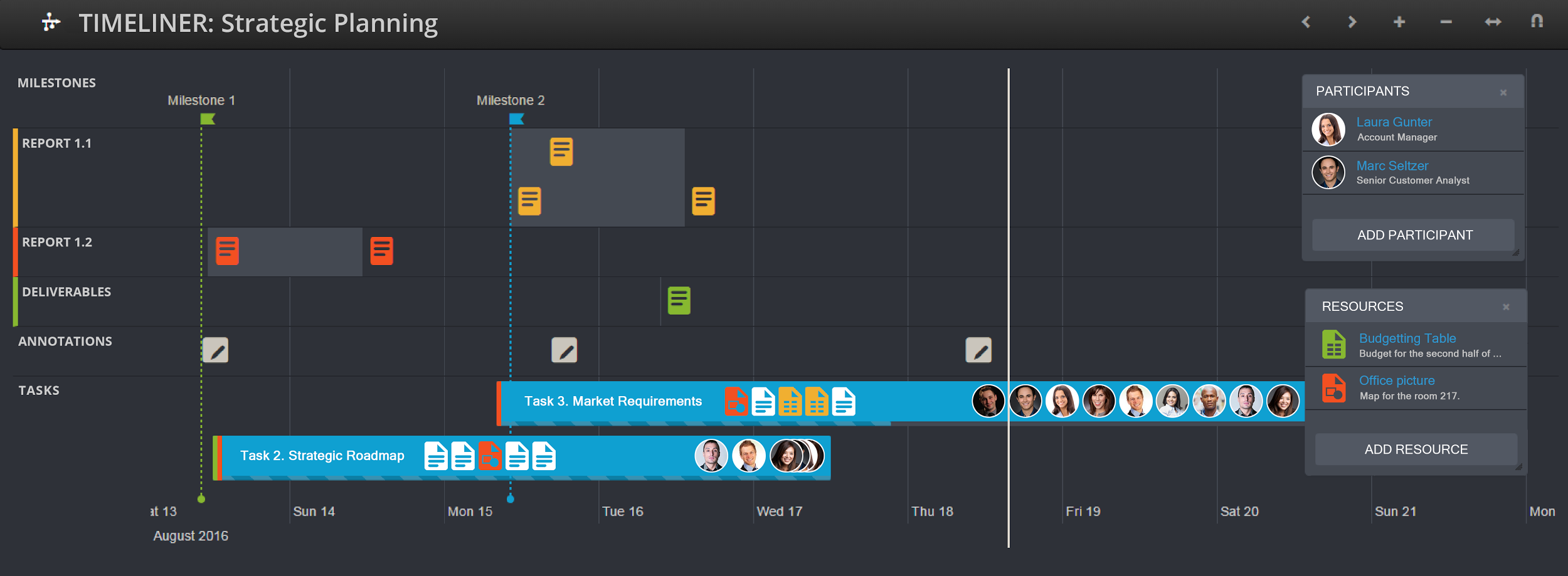TIMELINER is a lightweight, collaborative project-management web application. Timeliner was initially designed to support collaborative writing by facilitating the following activities:
pre-collaborative writing activities such as
- describing the goal of the writing task;
- pulling together the necessary documentation;
- selecting the tools for the task and participants notification;
collaborative writing activities such as
- team formation;
- writing task planning;
- document production and conclusion actions like getting the final group approval and sharing the result of the external approval process;
and post-collaborative writing activities such as
- reflecting on the accomplished writing task and
- possible integration with other tasks.
Features
- Collaborative definition of the subtasks and milestones of the overall goal alongside a timeline and to be reached alongside the project;
- Distribution of subtasks to project members;
- Distribution of relevant project resources to project tasks and members;
- Discussion of the defined milestones and tasks;
- Keeping the overview of the project status and current tasks and interdependencies by easily navigating the timeline and meaningfully filtering the contents.

Uses
Timeliner can be used for:
- Planning and managing collaborative writing;
- Project-based learning (has piloted in Estonian schools);
- Collaborative planning of healthcare-related activities;
- Planning and tracking the patient-related activities together with the patient;
- Interacting and visualizing of Patient Health Record
The potential benefits of using Timeliner are:
- acquiring a shared understanding of a project and the collaborative/ cooperative administration of it;
- evolving the project and its understanding alongside achieving the first project outcomes (flexible redefinition of tasks and goals with the acquired understanding — no static and outdated planning);
- As a result — efficient teamwork by the provision of a dynamic and collaboratively created boundary object coordinating shared project activities.
Tech specs
Timeliner is a self-hosted web application, indicating that it can be hosted within an own server infrastructure of an enterprise. It consists of front-end client and back-end server components. This approach allows for separation of concerns between these components and consumption of backend through the REST API, opting for openness, modularity and loose coupling of the functionality.
Both components use JavaScript as programming language and reuse the same well established, widely adopted and largely community-driven components and libraries.
Front-end client component is backed by widely adopted AngularJS framework and uses many of the fine modules that are being part of its ecosystem;
User Interface (UI) is based on:
- Angular Material UI Component framework, which is also a reference implementation of Google's Material Design Specification;
- Uses WebSockets through inclusion of Socket.IO for providing rich real-time features;
- vis.js brings in the highly extensible and powerful Timeline library;
- jQuery UI supplies robust Drag and Drop features;
- Lodash utility library provides just enough plumbing for the low level tasks;
- npm and Bower deal with package managing and Grunt deals with running tasks and other features required in development.
Back-end server component is based on
- Node.js JavaScript runtime with use of small yet powerful Koa web framework;
- MongoDB as a data storage and Mongoose for elegant object modeling;
- Socket.IO for seamless integration of WebSockets;
- Lodash for elegant implementation of low level coding tasks;
- Nodemailer to get the e-mail complexities out of the way;
- npm for powerful yet easy dependency management and
- JSON Web Tokens for API authorization flow.
Being built on top of well established and widely adopted components, makes Timeliner easily extendable for cases of new affordances being required, also allowing to work with same or similar ecosystem on both front- and back-end sides. That makes also possible to easily connect Timeliner to the Social Semantic Server (SSS) [link:I-02] with an aim to integrate it into Layers tools family. An integration on the level of Actor-Artefact Network with such tools as Bits and Pieces [link:T-08] and Learning Toolbox [link:T-03] promises establishing interesting frameworks for project based informal learning in workplace.
Timeliner is open-source software and both components can be found under the Learning Layers project GitHub repositories located at https://github.com/learning-layers/timeliner and https://github.com/learning-layers/timeliner-client
The Story
Timeliner was designed for supporting collaborative planning and project-based informal learning. Two main distinctions of Timeliner to other project-management tools are bottom-up collaboration architecture and lightweight concepts ontology. Timeliner does not use the traditional PMBok projecfft management ontology. Instead, it uses very simple and limited concepts like project, tasks, milestones, associated ressources, target documents and notes. This simplified approach makes Timeliner not suitable for traditional industrial projects, but allows use of the tool by wider audience because it does not require special training. The bottom-up collaboration architecture means that there is no main person in the project who is responsible for tasks’ management. Every participant invited in a project can add resources, notes, tasks and milestones. Everybody can assign the task to anybody, and everybody can reject the assignment. By supplying these rules with integrated chat, Timeliner provide for the participants a platform for collaborative way of agreement on project tasks.
Research
We have implemented just several iterations with testing involving end-users. There was a year of using Timeliner for project-based learning activities in the schools of Estonia and two workshops with healthcare specialist in General Practice in the North of England, UK. While we had quite positive feedback on the tool, the further research and development are required.
Contact
We look for the partners, who could be potentially involved in Co-design, business-application partners, technological partners. Interested in evaluation or integration scenarios? Please contact Dr Vladimir Tomberg, Narva mnt. 25 Tallinn, Estonia, email: vtomberg@tlu.ee
